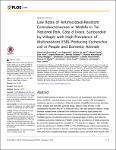Low Rates of Antimicrobial-Resistant Enterobacteriaceae in Wildlife in Taï National Park, Côte d’Ivoire, Surrounded by Villages with High Prevalence of Multiresistant ESBL-Producing Escherichia coli in People and Domestic Animals
Albrechtova, Katerina
Papousek, Ivo
Nys, Helene de
Pauly, Maude
Anoh, Etile
Mossoun, Arsene
Dolejska, Monika
Masarikova, Martina
Metzger, Sonya
Couacy-Hymann, Emmanuel
Akoua-Koffi, Chantal
Wittig, Roman M.
Klimes, Jiri
Cizek, Alois
Leendertz, Fabian
Literak, Ivan
Antimicrobial resistance genes can be found in all ecosystems, including those where antibiotic selective pressure has never been exerted. We investigated resistance genes in a collection of faecal samples of wildlife (non-human primates, mice), people and domestic animals (dogs, cats) in Côte d’Ivoire; in the chimpanzee research area of Taï National Park (TNP) and adjacent villages. Single bacteria isolates were collected from antibiotic-containing agar plates and subjected to molecular analysis to detect Enterobacteriaceae isolates with plasmid-mediated genes of extended-spectrum beta-lactamases (ESBLs) and plasmid-mediated quinolone resistance (PMQR). While the prevalence of ESBL-producing E. coli in the villages was 27% in people (n = 77) and 32% in dogs (n = 38), no ESBL-producer was found in wildlife of TNP (n = 75). PMQR genes, mainly represented by qnrS1, were also present in human- and dog-originating isolates from the villages (36% and 42% in people and dogs, respectively), but no qnrS has been found in the park. In TNP, different variants of qnrB were detected in Citrobacter freundii isolates originating non-human primates and mice. In conclusion, ESBL and PMQR genes frequently found in humans and domestic animals in the villages were rather exceptional in wildlife living in the protected area. Although people enter the park, the strict biosecurity levels they are obliged to follow probably impede transmission of bacteria between them and wildlife.
No license information
Related Items
Show related Items with similar Title, Author, Creator or Subject.
-
2010-11-18ZeitschriftenartikelCarbapenem-non-susceptible Enterobacteriaceae in Europe: conclusions from a meeting of national experts Grundmann, Hajo; Livermore, D. M.; Giske, C. G.; Canton, R.; Rossolini, G. M.; Campos, J.; Vatopoulos, A.; Gniadkowski, M.; Toth, A.; Pfeifer, Yvonne; Jarlier, V.; Carmeli, Y.The emergence and global spread of carbapenemase-producing Enterobacteriaceae is of great concern to health services worldwide. These bacteria are often resistant to all beta-lactam antibiotics and frequently co-resistant ...
-
2012-01-30ZeitschriftenartikelEmergence of OXA-48-type carbapenemase-producing Enterobacteriaceae in German hospitals Pfeifer, Yvonne; Schlatterer, Kathrin; Engelmann, Elisabeth; Schiller, Reinhold A.; Frangenberg, Hans Reiner; Stiewe, Doris; Holfelder, Martin; Witte, Wolfgang; Nordmann, Patrice; Poirel, LaurentNine carbapenem-resistant Enterobacteriaceae isolates collected from eight patients in five German hospitals were investigated. Six isolates produced the OXA-48 carbapenemase, and three isolates produced OXA-162, which is ...
-
2010-10-21ZeitschriftenartikelHigh-throughput microarray technology in diagnostics of enterobacteria based on genome-wide probe selection and regression analysis Friedrich, Torben; Rahmann, Sven; Weigel, Wilfried; Rabsch, Wolfgang; Fruth, Angelika; Ron, Eliora; Gunzer, Florian; Dandekar, Thomas; Hacker, Jörg; Müller, Tobias; Dobrindt, UlrichBackground: The Enterobacteriaceae comprise a large number of clinically relevant species with several individual subspecies. Overlapping virulence-associated gene pools and the high overall genome plasticity often ...

